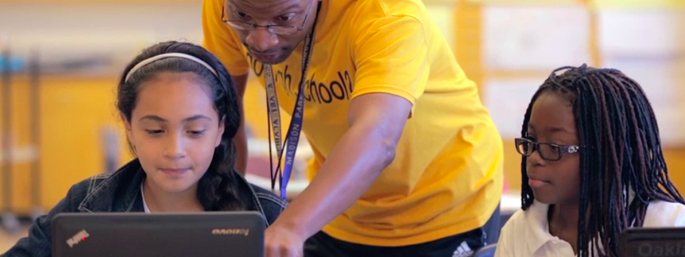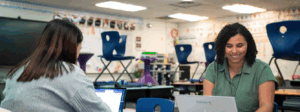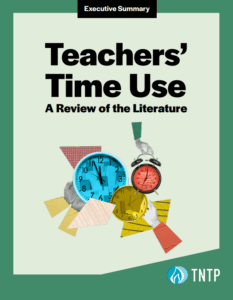Blended learning is growing rapidly, with half of high school students expected to engage in some form of online study by 2019. While considerable research has focused on the efficacy of distinct blending learning models, far less attention has been paid to the people developing and implementing those programs. While technology may open doors for students to broader and deeper content, it is really an opportunity for skilled teachers to use online programs to build on and enhance their existing practice. This is why blended learning—the strategic combination of in-person and virtual learning to personalize instruction—cannot replace good teaching; rather, it demands good teaching.
Over the past year, with support from The Learning Accelerator, TNTP visited more than 20 schools across the country to better understand how blended learning affects key human capital issues. We observed various instructional models in action and interviewed more than 60 teachers and leaders about their experiences.
On these visits, we saw educators breaking out of the traditional “25 students in a box” model, using technology in innovative ways to better serve each of their students; we saw a classroom where students moved seamlessly between working independently and receiving one-on-one instruction while using an online personalized playlist that laid out everything they needed to learn over the course of the year. We saw another school where teams of lead teachers and assistant teachers worked together in learning labs to guide students in targeted small group instruction.
These and many other classroom visits gave us insight into how new school models can increase the impact of great teachers on students. But blended learning models not only require teachers to adapt their practices, they require school systems to rethink models for teacher support, as well as their recruitment and selection strategies, to ensure teachers can take full advantage of the promise of blended learning models. Blended learning will usher in a new era of specialization and work sharing in schools. For teachers who longed for new ways to reach students, this is a very good thing.
Applying our learnings from our field research into blended learning models and our extensive work with educator talent strategies, we prepared guidance for educators in a working paper, now available for download. Here are the big headlines:
1. Blended learning doesn’t mean putting computers, tablets, and new software in front of students. Rather, blended learning is the intentional integration of online and in-person education to expand learning opportunities for students. Districts, CMOs, and schools trying blended learning should identify a clear goal driving the new approach to teaching and learning. When blended learning is truly integrated, the in-person teaching and online learning build off of each other, giving students more access to rigorous content, multiple ways to practice skills, and a variety of opportunities to demonstrate their learning.
2. As necessary as technology is, the real secret to effective blended instruction remains the same as any other classroom: It’s all about the people. Teachers and principals told us that the key to a successful blended learning program isn’t just in choosing software (although selecting excellent online content is critical). The bulk of the planning and execution of any lesson still falls on teachers, and the shift to blended learning means we need truly effective teachers now more than ever to ensure rigorous content is being taught and that the technology is being used to extend students’ learning opportunities.
3. The role of the teacher is no longer one-size-fits-all, so recruitment and selection must adapt. In most traditional classrooms, teachers are responsible for a laundry list of activities. In our visits, we saw schools where teachers weren’t sole operators. Instead, schools were staffed with teams of teachers working across content areas and grade levels and sharing responsibilities for everything from piloting new approaches to teaching and using data to match content to students, to facilitating personalized learning tools.
These differentiated teacher roles will require new ways of recruiting teachers, and districts need to be prepared to adapt. In addition to outreach to external candidates, recruitment should include looking to effective teachers already on staff, who possess the potential to grow into new roles. The selection process should screen candidates for the core competencies that will position them for success in blended classrooms: planning, classroom management, data usage, content expertise, collaboration and risk taking. Many high-performing teachers already possess these skills and will likely be enthusiastic about the opportunity to apply them in a new context. As a result, blended learning can support “smart” retention goals—creating a clear path for high-performing teachers to take on new challenges and advance their careers.
4. The way we develop and evaluate teachers must reflect the shifts in what teachers are expected to do. In a blended context, teachers need to exhibit many of the same skills we would expect in a traditional school model. But there are a number of behaviors and skills that are heightened, like effective planning and collaboration with colleagues. It’s hard to ad-lib and improve when more moving pieces must be in sync. Blended learning requires teachers to work in teams to plan and test new instructional practices and carefully assess their efficacy, while making thoughtful adjustments along the way. Our models for training teachers and providing feedback on their practices need to take into account these new demands.
For more detail on these four takeaways, as well as tools for districts to use as they pilot blended learning models, take a look at our new working paper and accompanying guidance tools. Over time, we hope to add to this toolkit as more schools and districts develop effective practices for supporting teachers to use blended learning to maximize their students’ learning opportunities.







